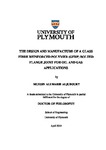The Design and Manufacture of a Glass Fibre Reinforced Polymer (GFRP) Bolted Flange Joint for Oil and Gas Applications
| dc.contributor.supervisor | Rizvi, Md Jahir | |
| dc.contributor.author | Aljuboury, Muhsin Ali Marie | |
| dc.contributor.other | School of Engineering, Computing and Mathematics | en_US |
| dc.date.accessioned | 2019-04-05T08:11:16Z | |
| dc.date.issued | 2019 | |
| dc.identifier | 10503464 | en_US |
| dc.identifier.uri | http://hdl.handle.net/10026.1/13659 | |
| dc.description.abstract |
Metallic bolted flange and pipes both have been increasingly replaced by fibre reinforced polymer (FRP) materials in many applications which deal with extreme harsh environments such as oil, gas, marine, chemical etc. However, only a handful of research works have been conducted regarding the bolted flange joint (BFJ) made of FRP materials. Also, the availabilities of standards and codes are very limited for the composite BFJ. Hence, the design guidelines for fabrication methods and dimensional considerations of bolted FRP flange are yet to be optimised fully. For instance, the ASME Boiler and Pressure Vessel Code, Section X, does not include specific rules for the design of bolted FRP flange joints. As a result, it is difficult to understand the consequences of the reliability of FRP flanges made with parametric variations and dimensional alterations. Therefore, the current research aims to produce a bolted GFRP flange joint with high performance through a series of experimentations and numerical simulations. A mould has been designed and manufactured using aluminium, glass, O-ring gasket and bolts. The bolted GFRP flanges have been fabricated using vacuum infusion process, polyester and fibreglass braid sleeves. Various experiments were conducted to solve the faced issues during the manufacturing process. Several experiments were carried out with different strain gauges to measure the bolt load. The GFRP flange has been assembled with other required components to produce the pressure vessel and tested under various bolt and internal pressure loads using different gaskets (Nitrile and Viton), which are suitable for the oil and the gas applications. Numerically, finite element analysis (FEA) of the BFJ comprised of composite flange and pipe, flange-pipe adhesive bonding, gasket and fastener has been conducted using ANSYS Mechanical. The FEA has been performed considering the orthotropic properties of the composite materials and the non-linearity behaviour of the rubber gasket. The FEA also includes the simulation of the fluid pressure penetration (FPP) between the flange and the gasket using the contact element real constant criterion (PPNC). Furthermore, another FEA model has been developed for a metal flange using the same boundary conditions as the GFRP flange. This flange has been investigated experimentally and numerically in published work [1]. The agreements between the obtained results and the previous results are excellent. This confirms the validity of the FEA performed in this project. The BFJ has been tested under various bolt and internal pressure loads experimentally and numerically and the strains in three directions (axial, hoop and radial) have been measured and calculated. The obtained results show that the influence of the bolt load is higher than the pressure load and the leakage pressure increases with increasing the bolt load. The effects of the flange dimensions on the maximum axial, hoop and radial strains, axial displacement, flange rotation and leakage pressure have been investigated using the FEA. The dimensions considered are the flange outer diameter and thickness, hub length and thickness. Most of the flange joint dimensions (within the selected range) have a small effect on the results and that confirms that the flange dimensions should be reduced to save the materials cost. The current flange is very strong and this is due to the good selection of the materials, fabric structure and the fabrication process, which gives high fibre content. In addition, the results show that the gasket materials and thickness has very small influences on the flange strains, axial displacement and rotation. The leakage pressure is affected by the gasket materials more than the thickness. | en_US |
| dc.description.sponsorship | The Higher Committee for Education Development (HCED) in Iraq, | en_US |
| dc.language.iso | en | |
| dc.publisher | University of Plymouth | |
| dc.subject | Bolted flange joint | en_US |
| dc.subject | Composite flange pipe connection | en_US |
| dc.subject | Flange joint for oil and gas applications | en_US |
| dc.subject | Manufacturing composite flange | en_US |
| dc.subject | Simulation composite flange | en_US |
| dc.subject | Leakage performance | en_US |
| dc.subject.classification | PhD | en_US |
| dc.title | The Design and Manufacture of a Glass Fibre Reinforced Polymer (GFRP) Bolted Flange Joint for Oil and Gas Applications | en_US |
| dc.type | Thesis | |
| plymouth.version | publishable | en_US |
| dc.identifier.doi | http://dx.doi.org/10.24382/680 | |
| dc.rights.embargodate | 2019-10-05T08:11:16Z | |
| dc.rights.embargoperiod | 6 months | en_US |
| dc.type.qualification | Doctorate | en_US |
| rioxxterms.version | NA | |
| plymouth.orcid_id | 0000-0002-7300-3056 | en_US |
Files in this item
This item appears in the following Collection(s)
-
01 Research Theses Main Collection
Research Theses Main


